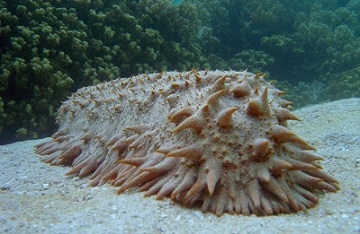It’s no secret that most animals release waste through their backsides, but some use that exit for more than releasing leftover food. Sea cucumbers use their rear end for at least five different functions — including breathing.
 Sea cucumber rear ends perform many functions. Credit: National Oceanic and Atmospheric Administration.
Sea cucumber rear ends perform many functions. Credit: National Oceanic and Atmospheric Administration.Sea cucumbers are echinoderms, a group that includes sea urchins and starfish, but sea cucumbers’ tube-like bodies look quite different. Inside their bodies are long respiratory trees, similar to human lungs, that come together just inside the anus. Muscles near the anus pump water in and out of the sea cucumber’s body to the respiratory trees. Some sea cucumber species pull in up to four cups of water every hour. The respiratory trees remove oxygen from the water, which is then distributed using hemoglobin, the same oxygencarrying protein found in many other animals but in no other echinoderms.
But the sea cucumber’s anus does much more than “breathe.” It also releases sperm and eggs for reproduction and offers the sea cucumber an interesting defense mechanism. When threatened, sea cucumbers shoot long, sticky threads out their anus that trap the potential predator. Some species take this ejection a step further: they eviscerate themselves, expelling their respiratory tree and digestive organs. But it’s no big loss for the sea cucumber. Just as starfish can regrow their rays, sea cucumbers can regrow their internal organs.
Recent research reveals that sea cucumbers may also extract nutrients from the water pumped through their anus. But the theory that sea cucumbers can “eat” through their anus is still new and needs more research. Either way, sea cucumbers’ rear ends are already doing five times the work of our own.


